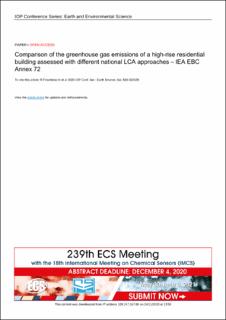| dc.contributor.author | Frischknecht, Rolf | |
| dc.contributor.author | Ramseier, L. | |
| dc.contributor.author | Yang, W. | |
| dc.contributor.author | Birgisdottir, Harpa | |
| dc.contributor.author | Chae, Ch U. | |
| dc.contributor.author | Lutzkendorf, Thomas | |
| dc.contributor.author | Passer, Alexander | |
| dc.contributor.author | Baloutski, M. | |
| dc.contributor.author | Berg, B. | |
| dc.contributor.author | Bragança, L. | |
| dc.contributor.author | Butler, J. | |
| dc.contributor.author | Cellura, M. | |
| dc.contributor.author | Dixit, MS. | |
| dc.contributor.author | Dowdell, D. | |
| dc.contributor.author | Francart, Nicholas | |
| dc.contributor.author | García Martínez, A. | |
| dc.contributor.author | Gomes, Vanessa | |
| dc.contributor.author | Wiik, Marianne Rose Kjendseth | |
| dc.contributor.author | Konig, H. | |
| dc.contributor.author | Llatas, C | |
| dc.contributor.author | Longo, S. | |
| dc.contributor.author | Lupisek, Antonin | |
| dc.contributor.author | Martel, J. | |
| dc.contributor.author | Mateus, R. | |
| dc.contributor.author | Nygaard Rasmussen, Freja | |
| dc.contributor.author | Ouellet-Plamondon, C. | |
| dc.contributor.author | Peuportier, Bruno | |
| dc.contributor.author | Pomponi, Francesco | |
| dc.contributor.author | Rock, Martin | |
| dc.contributor.author | Satola, Daniel | |
| dc.contributor.author | Soust Verdaguer, B. | |
| dc.contributor.author | Szalay, Z. | |
| dc.contributor.author | Truong Nhu, A. | |
| dc.contributor.author | Veselka, J. | |
| dc.contributor.author | Volf, M. | |
| dc.date.accessioned | 2020-11-24T15:52:48Z | |
| dc.date.available | 2020-11-24T15:52:48Z | |
| dc.date.created | 2020-11-03T10:37:24Z | |
| dc.date.issued | 2020 | |
| dc.identifier.issn | 1755-1307 | |
| dc.identifier.uri | https://hdl.handle.net/11250/2689418 | |
| dc.description.abstract | Introduction: The international research project IEA EBC Annex 72 investigates the life cycle related environmental impacts caused by buildings. The project aims inter alia to harmonise LCA approaches on buildings. Methods: To identify major commonalities and discrepancies among national LCA approaches, reference buildings were defined to present and compare the national approaches. A residential high-rise building located in Tianjin, China, was selected as one of the reference buildings. The main construction elements are reinforced concrete shear walls, beams and floor slabs. The building has an energy reference area of 4566 m2 and an operational heating energy demand of 250 MJ/m2a. An expert team provided information on the quantities of building materials and elements required for the construction, established a BIM model and quantified the operational energy demand. Results: The greenhouse gas emissions and environmental impacts of the building were quantified using 17 country-specific national assessment methods and LCA databases. Comparisons of the results are shown on the level of building elements as well as the complete life cycle of the building. Conclusions: The results of these assessments show that the main differences lie in the LCA background data used, the scope of the assessment and the reference study period applied. Despite the variability in the greenhouse gas emissions determined with the 17 national methods, the individual results are relevant in the respective national context of the method, data, tool and benchmark used. It is important that environmental benchmarks correspond to the particular LCA approach and database of a country in which the benchmark is applied. Furthermore, the results imply to include building technologies as their contribution to the overall environmental impacts is not negligible. Grant support: The authors thank the IEA for its organizational support and the funding organizations in the participating countries for their financial support. | en_US |
| dc.language.iso | eng | en_US |
| dc.publisher | IOP | en_US |
| dc.relation.ispartof | BEYOND 2020 – World Sustainable Built Environment conference | |
| dc.rights | CC BY 3.0 | * |
| dc.rights.uri | https://creativecommons.org/licenses/by/3.0/ | * |
| dc.title | Comparison of the greenhouse gas emissions of a high-rise residential building assessed with different national LCA approaches– IEA EBC Annex 72 | en_US |
| dc.type | Peer reviewed | en_US |
| dc.type | Journal article | en_US |
| dc.description.version | publishedVersion | en_US |
| dc.rights.holder | © 2020 The authors | en_US |
| dc.subject.nsi | VDP::Teknologi: 500 | en_US |
| dc.source.volume | 588 | en_US |
| dc.source.journal | IOP Conference Series: Earth and Environmental Science (EES) | en_US |
| dc.identifier.doi | 10.1088/1755-1315/588/2/022029 | |
| dc.identifier.cristin | 1844403 | |
| dc.relation.project | Norges forskningsråd: 257660 | en_US |
| dc.source.articlenumber | 022029 | en_US |
| cristin.ispublished | true | |
| cristin.fulltext | original | |
| cristin.qualitycode | 1 | |

